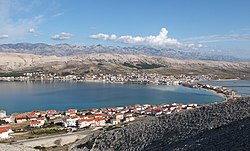Pag (town)
This article needs additional citations for verification. (January 2011) |
Pag | |
|---|---|
 View of the town | |
 Pag Location of Pag within Croatia | |
| Coordinates: 44°29′N 14°57′E / 44.483°N 14.950°E | |
| Country | |
| County | |
| Island | Pag |
| Government | |
| • Mayor | Ante Fabijanić Njokulin (MODES) |
| Elevation | 0 m (0 ft) |
| Population (2011)[1] | |
| • Total | 3,846 |
| Time zone | UTC+1 (CET) |
| • Summer (DST) | UTC+2 (CEST) |
| Postal code | 23 250 |
| Area code(s) | 023 |
| Website | www |
Pag (Italian: Pago, German: Baag) is the largest town on the island of Pag, with a population of 2,849 (2011) in the urban core and 3,846 in the entire municipality.[1]
Coordinates: 44°26.61′N 15°03.27′E / 44.44350°N 15.05450°E
History[]
Medieval Pag emerged near the salterns where the abandoned Old Town used to be, 3 kilometres (2 miles) south of the present location. According to historical documents, the name Pag was mentioned for the first time in the 10th century. In 976, the Croatian king Stjepan Držislav took Pag from the Byzantine authority and appointed a Croatian district Prefect as the administrator of the town. In 1102, the Croatians voluntary formed a union with Hungary under King Coloman, as they had a succession crisis after the death of Demitrius Zvojnomir. Hungary did agree to maintain the Croatian nobility, with the Sabor (Council of Croatian nobles) and a ban (Croat viceroy).
In 1244 Hungarian king Béla IV granted Pag the status of a free royal town. After the rebellion against Zadar, Pag obtained partial autonomy, and Ludovic I acknowledged its full autonomy in 1376 as to all other Dalmatian towns. In the battles against Zadar which took place in 1394 Pag suffered a heavy defeat and devastation, and the inhabitants moved to a new location, where the present Pag was founded.
In 1403, King Louis the Great, the King of Hungary and also of Croatia and Poland, sold his share of Dalmatia, Pag included, to Venice and thus sentenced Pag to a centuries-long life under Venetian rule. In 1433 Pag received the Town Statute, one of the first documents of that sort in Croatia.
In the middle of the 15th century, the Ottoman threat kept rising and therefore the inhabitants of Pag decided to build a new town. The construction works began on today's location of the town, on 18 May 1443. The urban plans of the new town were developed in Venice respecting the principles of architecture and urbanism of that time. Giorgio da Sebenico (= Juraj Dalmatinac), a great constructor and sculptor participated in the development of the urban plan.
In the 19th century, the town was ruled by the Austrian monarchy, Dalmatia Province, until the creation of the Kingdom of Serbs, Croats and Slovenes in 1918, under the bilingual name Pag-Pago.
In the late 19th century and the early 20th century, the town of Pag had 4700 inhabitants. In later years, and especially in 1905, following the emergence of a blight, which had destroyed the vineyards, the population started declining. Many inhabitants emigrated, mostly to the United States, Canada and Australia.
Another wave of depopulation of Pag town and island took place at the end of the Second World War. In this period, the nobility completely ceased to exist.
During the Croatian War of Independence in 1991, the only link between southern and northern Croatia was the island Pag, thanks to the bridge that connects it to the mainland on the south and a ferry line on the north of Pag.
Pag 1443

View of Pag from West.

Pag promenade

Basilika Assumption of Mary
A bridge in Pag

The-prince's-palace

Bronze bust of Bartol Kašić

Bronze statue of a Pag lace-maker
Famous lacework of Pag

Austrian stamp bilingual cancelled in 1896
Cultural heritage[]
Pag was the seat of a Roman Catholic Bishop of Cissa.
In 1443 the new town was founded and built according to new principles of town-planning. The longitudinal and the transversal streets, the latter known as Vela ulica, intersect at a right angle, forming in this way a rectangular square with the Collegiate Church, the Duke's Palace and the unfinished Bishop's Palace, which, as well as the town walls, were built by the famous mason and sculptor Giorgio da Sebenico.
The Collegiate Church is a three-nave basilica with three apses. The simple front is decorated with a Gothic portal, a Renaissance rosette and unfinished figures of the saints. In 1466 Juraj Dalmatinac became supervisor of the construction works on the church, while the building itself was carried out by his disciples; finished not before the beginning of the 16th century; restored in the 18th century, when the stucco work on the ceiling was performed. The church accommodates valuable works of art: the altar painting Our Lady of the Rosary, the Gothic wooden cross, and the silver processional crucifix and reliquaries are safeguarded in the treasury. The bell tower with its present height was erected in 1526.
In the Benedictine church of St. Marguerite, constructed after the plan of Giorgio da Sebenico, a silver processional cross and reliquaries are kept. The church of St. George, bearing Renaissance features, is a work of local masons from the 16th century.
There are several houses and smaller palaces with Renaissance façades, portals and coats of arms of local noble families in the town.
The Old Town includes partially preserved walls and the main church, a three-nave basilica built in the Romanesque style; the fronts of the Romanesque and Gothic styles were built in 1392 by the sculptor Paul from Sulmona. The ruins of a Franciscan monastery from 1589 are near the church.
Pag Town is also the place of origin of Paška čipka, the famous lacework whose first mention is related to sisters of the Order of Saint Benedict in 1579.[2]
Economy[]
Traditionally, cattle and sheep breeding, along with salt extraction, fishing and agriculture have been the basis of survival on the island throughout the centuries. The tradition of salt extraction most probably originates from the times of the first settlement in this area.
These traditional activities have been maintained until the present day. Now, around 40,000 sheep are kept on the island. Also, around 33,000 tons of salt are produced yearly, making ⅔ of the total production in Croatia. The salt basins are spread over 3.01 square kilometres (301.00 hectares).
The most important economic activity, not only for the inhabitants, is tourism. Tourism on the island of Pag has seen a boom in the last decades. A large, well-maintained public beach, particularly suitable for families with children, lies not far from the centre of the town. The famous lacework of Pag, the best-known national lacework, is produced here, and in the local cheese-monger's shop one of the most famous authentic national sorts of cheese - Paški sir - may be found. The prominent national costumes are also categorized as national souvenirs. The present rich touristic offering of Pag, which - along with the impressive landscape - stone lace in the sea - make Pag and the Pag Bay an exquisite tourist resort.
Gallery[]
References[]
- ^ Jump up to: a b "Population by Age and Sex, by Settlements, 2011 Census: Pag". Census of Population, Households and Dwellings 2011. Zagreb: Croatian Bureau of Statistics. December 2012.
- ^ Portada, Josip. "Kolekcija paške čipke sestara benediktinki proglašena kulturnim dobrom Hrvatske". ezadar.rtl.hr (in Croatian). Retrieved 2018-02-10.
External links[]
| Wikimedia Commons has media related to Pag. |
- Cities and towns in Croatia
- Populated places in Zadar County
- Pag (island)

























